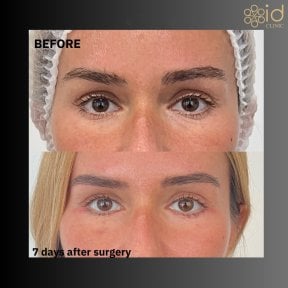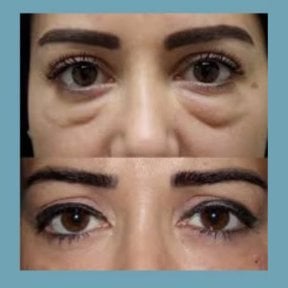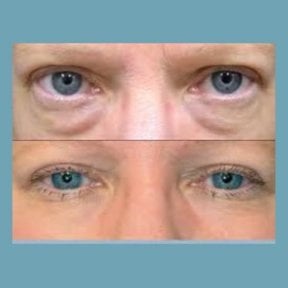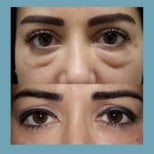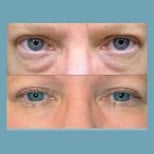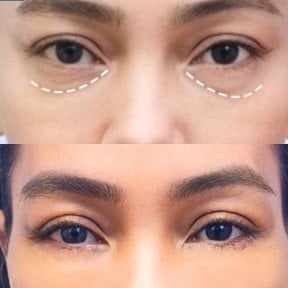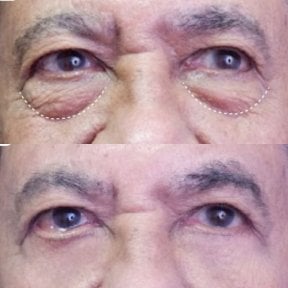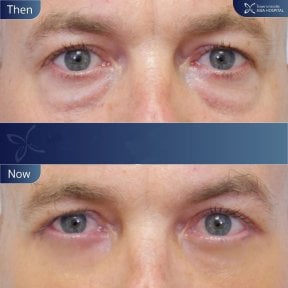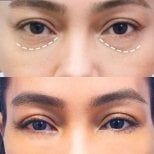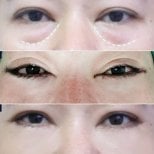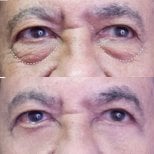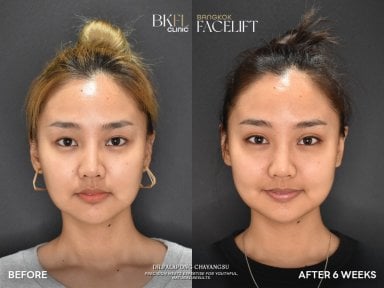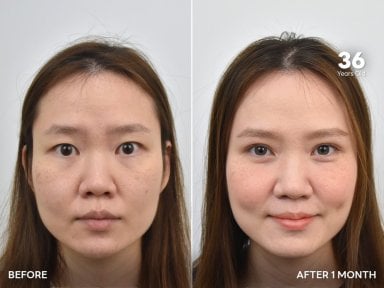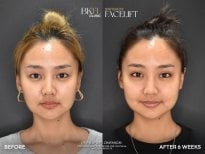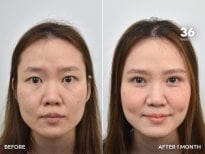Dr Phatcharasak Kraisornphongsakul has performed 20,000+ procedures over 33 years, specializing in transconjunctival lower blepharoplasty with no external scarring. The package may cost around $1,400 – typically covering surgeon fees, anesthesia, lab tests, medications, and transfers. The Royal College of Surgeons Thailand-accredited clinic sees 4,000 international patients annually. Dr Phatcharasak focuses on natural-looking eye contour enhancement with local anesthesia.
What Is Blepharoplasty?
Blepharoplasty, also called eyelid surgery, is a procedure that removes or reshapes excess skin, fat, or muscle around the eyes. It’s performed on the upper eyelids, lower eyelids, or both — depending on what each patient needs. Patients choose it to achieve a more refreshed, awake look or to improve vision affected by sagging skin.
✅ This surgery helps with:
- Droopy upper lids that can block vision.
- Puffy under-eyes or eye bags.
- Wrinkled, loose skin around the eyes.
- Tired or aged facial appearance.
In Thailand, blepharoplasty is one of the most popular procedures for both cosmetic and medical reasons. Clinics use advanced methods like laser or radiofrequency-assisted tools for more precise work and faster healing.
Eyelid Surgery Options Available Abroad
Several types of eyelid lifts are available to meet different cosmetic or functional needs.
🟦 Upper eyelid surgery
Removes loose skin and fat from the upper eyelid. It’s commonly chosen by patients with droopy lids that cause a tired appearance or limit their field of vision.
🟨 Lower eyelid correction
Targets puffiness and under-eye bags. The surgeon may remove or reposition fat and gently tighten the skin to smooth out the area below the eyes.
🟩 Eye bag removal
A focused version of lower blepharoplasty is often performed in leading Bangkok clinics. It reduces swelling or bulges under the eyes without altering the upper lid.
🟥 Double eyelid procedure
Creates a defined crease in the upper eyelid. This technique is popular among patients with monolids who want a more open or balanced eye shape while keeping their natural features.
🟧 Revision surgery
Corrects the outcome of a previous eyelid operation. It may involve adjusting asymmetry, smoothing leftover puffiness, or improving scars.
🟫 Minimally invasive techniques
Thai medical centers now offer laser-assisted blepharoplasty or radiofrequency options, which are less invasive and allow quicker healing. These are often preferred by patients traveling from abroad.
💡 During your consultation, the surgeon will recommend the most suitable approach based on your eye structure, age, skin condition, and recovery goals.
Who Is a Good Fit for Eyelid Rejuvenation?
Eyelid surgery isn’t just about looks — it can also improve vision and comfort. Still, not everyone is the right match for this procedure.
✅ You may be a good candidate if you:
- Have sagging skin on your upper eyelids that affects appearance or sight.
- Notice puffiness or bags under your eyes that don’t go away with rest.
- Are in good general health and free from severe eye conditions.
- Don’t smoke or are willing to stop before and after the procedure.
- Have realistic expectations and understand the recovery process.
📊 A growing number of patients between 40 and 65 seek eyelid surgery, although younger and older people also qualify based on their needs.
❌ You may be asked to wait or reconsider if you:
- Have untreated eye conditions like glaucoma or dry eye.
- Are currently smoking and cannot pause during recovery.
- Suffer from uncontrolled diabetes, bleeding disorders, or immune issues.
- Are pregnant or recently had surgery on or around the eyes.
- Expect results that aren’t realistically achievable with this procedure.
💡 Thai clinics working with international patients usually include a medical screening, eye exam, and consultation before confirming surgery. These checks help ensure safety and the best possible outcome.
How Does the Procedure Work?
Most procedures take 1 to 2 hours and are performed under local anesthesia with sedation or general anesthesia (especially when combined with other surgeries).
👉Here’s what typically happens:
- Pre-op exam — blood tests, eye check, and a surgical plan.
- Marking the eyelid area — to guide tissue removal.
- Surgical correction — removing or repositioning skin, fat, and sometimes muscle.
- Fine sutures are used to close the incision.
- Monitoring — short recovery in the clinic before going back to the hotel or staying overnight.
What Recovery Looks Like
Recovery after blepharoplasty is straightforward for most patients. Swelling and bruising are common at first but improve quickly with proper care.
🕒 Recovery timeline
| Timeframe | What to expect |
| Day 1–2 | Swelling and bruising begin; rest is essential. |
| Day 3–7 | Stitches (if any) are removed; bruising fades. |
| Week 2–3 | Most swelling goes down; eyes look more natural. |
| 1–2 months | Final results appear; scars continue to fade. |
📝 Post-op tips:
- Sleep with your head slightly elevated.
- Apply cold compresses as advised.
- Avoid eye makeup and contact lenses for 1–2 weeks.
- Protect your eyes from sunlight.
- Avoid heavy lifting and strenuous activities for 2–3 weeks.
💡 Most international patients stay 5–7 days near the clinic. Follow-up is typically done in person before leaving the country, with further support available online after travel.
Why Patients Choose Thailand for Eyelid Surgery
Thailand welcomes over 1.4 million international patients each year. It is the leading destination for medical tourism in Asia. The industry is expected to grow by 43% and reach $16 billion by 2030.
Highly trained plastic surgeons
Thai surgeons are certified by the Medical Council of Thailand and hold memberships in leading professional organizations, including:
- The International Society of Aesthetic Plastic Surgery (ISAPS).
- The Society of Aesthetic Plastic Surgeons of Thailand (THSAPS).
Most have completed fellowships or advanced training in the US, South Korea, or Japan.
Clinics with global safety certifications
Top facilities in Bangkok, Phuket, and Chiang Mai are accredited by:
- The Joint Commission International (JCI).
- The Hospital Accreditation of Thailand (HA).
- The International Organization for Standardization (ISO 9001).
These certifications ensure consistent surgical safety, infection control, and patient care standards.
Modern, minimally invasive techniques
Options like laser-assisted blepharoplasty, radiofrequency tools, and dissolvable sutures help reduce downtime — ideal for short, planned recovery stays.
💡 According to ISAPS, eyelid surgery remains one of the top 3 cosmetic procedures globally, and Thailand ranks among the most preferred countries for international patients.
What’s Included in Thai Blepharoplasty Packages
Eyelid surgery cost in Thailand is significantly lower, with full packages often 60–80% cheaper than in the US or UK.
Most clinics in Thailand offer all-inclusive packages designed specifically for international patients. These bundles help simplify the process and reduce unexpected costs.
💚 Patients book the best blepharoplasty in Thailand through platforms like Bookimed, which offer package options at official clinic prices — often with exclusive discounts or added benefits like extended aftercare or hotel perks.
👉The table below outlines what’s usually included and what’s worth double-checking before booking.
| ✅ Most likely included | ⚠️ Needs additional confirmation |
| Upper or lower blepharoplasty surgery. | Combined procedures (e.g., facelift, brow lift). |
| Initial consultation with a plastic surgeon. | Premium hotel or room upgrades. |
| Local or general anesthesia. | Extra nights at hospital or hotel. |
| Basic pre-op blood tests. | Special lab tests for high-risk patients (e.g., ECG, imaging). |
| Post-op medications for pain and infection control. | Lymphatic massage or recovery spa services. |
| 1–2 nights in hospital or clinic accommodation. | Meals during hotel stay (outside hospital). |
| Round-trip transfers (airport, hotel, clinic). | Return transportation to the airport if travel dates change. |
| Post-op check-up before departure. | Long-term follow-up after returning home. |
| English-speaking support/translator. | Extra compression garments or aftercare products. |
| Written recovery instructions and medication list. | Travel insurance or medical complication coverage. |
What to Expect Before Traveling
Planning eyelid surgery abroad takes more than booking a flight — but clinics in Thailand make the process smooth for international patients.
👉Here’s what to know before your trip.
Visa requirements
Most visitors from Europe, the UK, the US, Australia, the UAE, and Southeast Asia can enter Thailand visa-free for up to 30 days. Apply for a tourist visa through the Thai eVisa system or iVisa for longer stays. The government backs the sector with a 90-day medical visa.
Clinic stay & recovery time
Expect to stay in Thailand for 5 to 7 days:
- 1 day for a pre-surgery consultation.
- Surgery day.
- 2–3 days of nearby recovery.
- 1 post-op follow-up before flying home.
Some patients stay a few extra days to rest more comfortably in a hotel or resort setting.
Payment methods
Clinics typically accept:
- Thai Baht (THB), USD, and Euros.
- Credit/debit cards.
- Bank transfers (often required in advance for booking).
💡 Ask about possible surcharges for card payments or currency conversion. Paying in local currency may help avoid extra fees.
